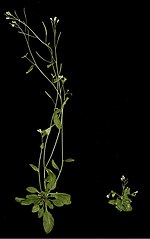
Back Planthormoon Afrikaans هرمون نباتي Arabic Fitohormona AST Фитохормон Bulgarian উদ্ভিদ হরমোন Bengali/Bangla Biljni hormon BS Fitohormona Catalan Fytohormon Czech Plantehormon Danish Phytohormon German

Plant hormones (or phytohormones) are signal molecules, produced within plants, that occur in extremely low concentrations. Plant hormones control all aspects of plant growth and development, including embryogenesis,[1] the regulation of organ size, pathogen defense,[2][3] stress tolerance[4][5] and reproductive development.[6] Unlike in animals (in which hormone production is restricted to specialized glands) each plant cell is capable of producing hormones.[7][8] Went and Thimann coined the term "phytohormone" and used it in the title of their 1937 book.[9]
Phytohormones occur across the plant kingdom, and even in algae, where they have similar functions to those seen in vascular plants ("higher plants").[10] Some phytohormones also occur in microorganisms, such as unicellular fungi and bacteria, however in these cases they do not play a hormonal role and can better be regarded as secondary metabolites.[11]
- ^ Méndez-Hernández HA, Ledezma-Rodríguez M, Avilez-Montalvo RN, Juárez-Gómez YL, Skeete A, Avilez-Montalvo J, et al. (2019). "Signaling Overview of Plant Somatic Embryogenesis". Frontiers in Plant Science. 10: 77. doi:10.3389/fpls.2019.00077. PMC 6375091. PMID 30792725.
- ^ Shigenaga AM, Argueso CT (August 2016). "No hormone to rule them all: Interactions of plant hormones during the responses of plants to pathogens". Seminars in Cell & Developmental Biology. 56: 174–189. doi:10.1016/j.semcdb.2016.06.005. PMID 27312082.
- ^ Bürger M, Chory J (August 2019). "Stressed Out About Hormones: How Plants Orchestrate Immunity". Cell Host & Microbe. 26 (2): 163–172. doi:10.1016/j.chom.2019.07.006. PMC 7228804. PMID 31415749.
- ^ Ku YS, Sintaha M, Cheung MY, Lam HM (October 2018). "Plant Hormone Signaling Crosstalks between Biotic and Abiotic Stress Responses". International Journal of Molecular Sciences. 19 (10): 3206. doi:10.3390/ijms19103206. PMC 6214094. PMID 30336563.
- ^ Ullah A, Manghwar H, Shaban M, Khan AH, Akbar A, Ali U, et al. (November 2018). "Phytohormones enhanced drought tolerance in plants: a coping strategy". Environmental Science and Pollution Research International. 25 (33): 33103–33118. Bibcode:2018ESPR...2533103U. doi:10.1007/s11356-018-3364-5. PMID 30284160. S2CID 52913388.
- ^ Pierre-Jerome E, Drapek C, Benfey PN (October 2018). "Regulation of Division and Differentiation of Plant Stem Cells". Annual Review of Cell and Developmental Biology. 34: 289–310. doi:10.1146/annurev-cellbio-100617-062459. PMC 6556207. PMID 30134119.
- ^ "Plant hormones". NCS Pearson. Archived from the original on 2021-11-27. Retrieved 2018-08-14.
- ^ "Plant Hormones". Archived from the original on 2019-12-18. Retrieved 2018-08-14.
- ^ Went FW, Thimann KV (1937). Phytohormones. New York: The Macmillan Company.
- ^ Tarakhovskaya ER, Maslov Y, Shishova MF (2007). "Phytohormones in algae". Russian Journal of Plant Physiology. 54 (2): 163–170. doi:10.1134/s1021443707020021. S2CID 27373543.
- ^ Rademacher W (1994). "Gibberellin formation in microorganisms". Plant Growth Regulation. 15 (3): 303–314. doi:10.1007/BF00029903. S2CID 33138732.